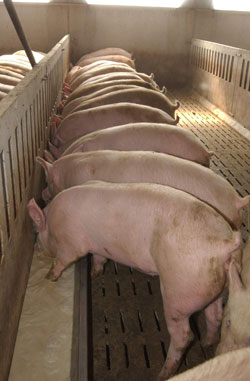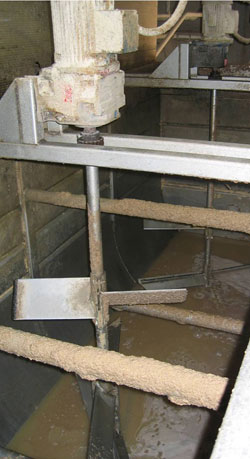 The supply of wet feed, when compared to dry feed, improves the rate of growth and conversion, at least these are the results of the trials carried out in the experimental stations. However, the results are often negative, sometimes because of design errors, but more frequently because of negligence in the maintenance of the installations (especially the microbiological aspect).
The supply of wet feed, when compared to dry feed, improves the rate of growth and conversion, at least these are the results of the trials carried out in the experimental stations. However, the results are often negative, sometimes because of design errors, but more frequently because of negligence in the maintenance of the installations (especially the microbiological aspect).
The dilution
On this occasion we are only going to discuss the dilution in the finishing period. According to the information a high dilution (3: 1 - 3.5:1) facilitates the enzyme activity and reduces the viscosity and the transit speed of the intestinal content (all these effects improve the digestibility and the conversion rate). On the other hand it increases the volume of waste water and the cost of its elimination (Table 1). Some sources also emphasize the power cost to maintain homeothermy (the water has a lower temperature than that of the body). Each farm should find its own acceptable level of dilution according to its particular characteristics. The operators’ shared recommendations are in Table 2. The rates above 3:1, are not justified nutritionally, but they are used when the pumps are not prepared to push through a denser soup. First of all the farmer must think about his facilities and feed composition, and then, with the margin that he’s left with, he can think about reducing the waste water.
Table 1: Effects of dilution on performance and the volume of waste water of the products.
| Source | Dilution (water:feed) | Effects |
| Gill et al., 1987 | 2:1 – 2.5:1 – 3:1 – 3.5.1 | The lineal improvement of the growth and conversion rate when increasing the dilution. |
| Barber et al., 1991 | 2:1 – 2.7:1 – 3.3:1 – 4:1 | The lineal increase of the digestibility of dry material and digestible energy on increasing dilution. |
| O’Connell-Motherway et al., 1998 | 2:1 – 3:1 – 4:1 | The lineal increase in the consumption of water (liquid – feed) and the volumes of waste water (62% in 2:1, 108% and more for 3:1 and 4:1, respectively) |
| Beal et al., 2002 | 2.5:1 – 3.2:1 – 5:1 – 10:1 | Better yield relating to 2.5:1 and 3.2:1 |
| Hurst et al., 2008 | 1.5:1 – 3:1 | Similar yield within the indexes of dilution. |
Dilution and the number of daily feeds
The number of daily feeds has also been evaluated: some indicate two and others three feeds a day. In practice, the majority of the Italian farms provide two feeds (especially since European regulations have imposed automatic water dispensers). It is important to consider these questions in the most critical situations: the adaptation of the piglets weaned to liquid feed and the really strict rationing in the fattening unit.
The adaptation of the weaned piglets
The pigs with a live weight of 25-30 kg, used to dry feed, consume 1,3 -1,6 kg of feed a day, a quantity that cannot be maintained in the new liquid feed environment. This happens because the animal, being used to chewing its feed all day, must adapt to consuming the soup on only two occasions every 24 hours. To sum up, the quantity of food is large, the time limited and the reduction of intake unavoidable. In this case, the reduction of the rate of dilution and the three feeds a day would be positive. So the recommended proportion for the weaned piglets is inferior to 2.4:1 (Table 2). Force-feeding to recover the yield leads to the provocation of diarrhoea. In fact the adaptation is not only a question of physical capacity, but also of digestion and the prevalence of intestinal microbes. Strict rationing would accentuate the inequalities and competition, which could lead to diarrhoea in the dominant animals and reduce the homogeneity of the group.
Table 2: Recommended dilutions

| Dilution | Phase - Notes |
|
2.0:1 – 2.2:1 |
Value assuming normal water intake and dry food |
|
1.5:1 – 2.4:1 |
Recently weaned piglets* |
|
2.6:1 – 2.8:1 |
Growth |
|
2.8:1 – 3.0:1 |
Finish |
|
3.0:1 – 3.2:1 |
Growth - finish (feed based on wheat or beetroot pulp) |
| 3.2:1 – 3.4:1 | Growth - finish with whey as a substitute for water |
* without drinker guarantee 10% water in relation to live weight
Feed restriction in the fattening unit
 Drastic rationing in the fattening unit could become necessary for various reasons: for the economic penalties for excessively fatty carcasses, or when, in Italy, pigs for DOP hams reached 160 kg before they were 9 months old (minimum age for sacrifice). Feed restriction increases competition in the corral and the voracity of the dominant leaders, a situation in which the feeder space becomes important. With more animals there is more competition and anxiety which increases the appetite of the dominant pigs. They place themselves in front of the feed tube and, with a nose or a leg, try to slow down the solid component as it comes out of the feeder being able to take in a more concentrated puree (on these occasions an increase in the dilution would be useful). To sum up, the greedy pigs are the ideal candidates for the Hemorrhagic bowel syndrome. The intake of large volumes implies a reduction in digestion, a condition which, together with the difficulties in the stomach to acidify the contents, causes its immediate fermentation and the corresponding production of gas. The gas expands the stomach and the intestine can become partially twisted: one more obstacle for the digestion and an additional stimulus for microbial fermentation. The pressure of the gas can harm the intestinal vessel and cause an intestinal haemorrhage, or pressure on the lungs, provoking respiratory complications, or compress other vessels in the abdominal cavity the occlusion of which could cause cardiac arrest. This situation begins with bad behaviour and also an increase in competition.
Drastic rationing in the fattening unit could become necessary for various reasons: for the economic penalties for excessively fatty carcasses, or when, in Italy, pigs for DOP hams reached 160 kg before they were 9 months old (minimum age for sacrifice). Feed restriction increases competition in the corral and the voracity of the dominant leaders, a situation in which the feeder space becomes important. With more animals there is more competition and anxiety which increases the appetite of the dominant pigs. They place themselves in front of the feed tube and, with a nose or a leg, try to slow down the solid component as it comes out of the feeder being able to take in a more concentrated puree (on these occasions an increase in the dilution would be useful). To sum up, the greedy pigs are the ideal candidates for the Hemorrhagic bowel syndrome. The intake of large volumes implies a reduction in digestion, a condition which, together with the difficulties in the stomach to acidify the contents, causes its immediate fermentation and the corresponding production of gas. The gas expands the stomach and the intestine can become partially twisted: one more obstacle for the digestion and an additional stimulus for microbial fermentation. The pressure of the gas can harm the intestinal vessel and cause an intestinal haemorrhage, or pressure on the lungs, provoking respiratory complications, or compress other vessels in the abdominal cavity the occlusion of which could cause cardiac arrest. This situation begins with bad behaviour and also an increase in competition.Conclusions
Often the characteristics of the installation do not allow the application of what is suggested in the information. However, once established, the dilution which is compatible with the distribution system, the composition of the diet may have further commitments. The final decisions should be saved for health and special behaviour situations. If we are able to control all these factors, then we can worry about the water consumption and the volume of the waste water.



